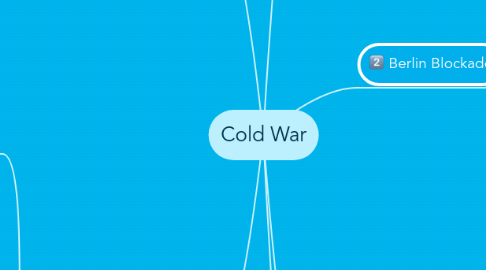
1. Early Days
1.1. Unease between Ideologies
1.1.1. US wary of Communism since Lenin and Trotsky rose up against Tsar Nicholas II
1.1.1.1. British and US both sent troops to support Whites during Civil War instead of the Bolsheviks
1.1.1.2. That loss shattered connections between the nations.
1.1.2. Differences emerged during Potsdam.
1.1.2.1. Russia wanted Germany industrialized for their shared benefits (through labor, factories etc.)
1.1.2.2. US wanted to leave Germany to prosper on its own and turn into a new, viable trading partner.
1.1.3. Superpower Growth
1.1.3.1. Communists openly targeted in US "McCarthyism"
1.1.3.2. Stalin wanted protection from West - "Iron Curtain"
1.2. Mass changes to weaponry
1.2.1. Development of Atomic Bomb
1.2.1.1. US had the Manhattan Project
1.2.1.1.1. Was A-Bomb in Japan a message to Stalin from Truman?
1.2.1.2. USSR began to develop their own.
1.2.2. Economic Inabilities
1.2.2.1. Marshall Plan
1.2.2.1.1. Rebuilding the economies of Europe post-WWII
1.2.2.1.2. Aimed to halt extremism (like in WWII start)
1.2.2.2. Warsaw Pact
1.2.2.2.1. Used by Soviets to gauruntee the control of satellites
2. Warsaw Pact
2.1. Changes to Leadership
2.1.1. Stalin died in 1953
2.1.2. Replaced by Khruschev
2.1.2.1. Known for threats of nuclear weapons
2.1.2.2. Still pushed for "peaceful co-existence of ideologies".
2.2. Eisenhower/Dulles
2.2.1. Believed in the power of "rolling back" communism
2.2.2. Wanted to liberate those who didn't agree with leaders
2.2.3. Brinkmanship (just like Khruschev)
2.3. Hungary Revolution 1956
2.3.1. Khrushchev removed Stailin's puppet leader
2.3.2. New leader began using secret police to establish free elections.
2.3.3. Not the freedom Khruschev was offering and Russia invaded, killing Prime Minister Imey Nagy.
2.4. WARSAW Pact signed 1955
2.4.1. Soviet Union
2.4.2. Albania
2.4.3. Bulgaria
2.4.4. Poland
2.4.5. Romania
2.4.6. Czechoslovakia
2.4.7. East Germany
2.4.8. Hungary
3. Robert Service: Their common goals were to maintain the one-party, one-ideology state, to expand its economy, to control all public institutions and their personnel, to mobilise the rest of society, to secure the Soviet Union’s domination of Eastern Europe and to expand communist influence around the world.
3.1. Gaddis: neither superpowers should claim equal responsibility for onset of conflict, but US constraints from domestic politics.
4. MEANT TO BE A SHORT TERM AFFAIR - THE PLAN WAS FOR GERMANY AND BERLIN TO BE RECONNECTED ONCE STABLE.
5. Berlin Blockade
5.1. US/Britain/France merged zones in West Berlin without informing or asking Russia.
5.1.1. Made same currency used.
5.1.2. Allowed for free elections to decide governing body
5.1.3. Sub task
5.2. Russian zones tasked with industrializing for resources.
5.2.1. Two initial months of Soviet control caused major damages to be inflicted onto the city
5.2.1.1. Factories stripped of goods
5.2.1.2. Women Raped
5.2.1.3. Homes pillaged
5.2.1.4. Families slaughtered
5.2.2. At Potsdam, Stalin had control over majority of Eastern Europe
5.2.2.1. Baltic states
5.2.2.2. Czechoslovakia
5.2.2.3. Hungary
5.2.2.4. Ukraine
5.2.2.5. Bulgaria
5.2.2.6. Romania
5.2.3. Aimed for quadrilateral control of Berlin, which the allies ignored in order to join their "democratic" sectors together, causing anger from Stalin
5.3. Blockade halted movement of goods on land and rivers from West Germany to West Berlin
5.3.1. After no gauruntee of movement of goods through East Berlin was made
5.3.2. General Lucius Clay then blocked transfer of dismantled factors to Soviet Union.
5.3.3. This angered Soviet leadership, leading to the blockade.
6. Korean War
6.1. UN supported the South Koreans
6.1.1. US provided 88% of troops
6.1.2. Forced North Koreans to retract troops from the 38th Parallel after apparant attacks on the South.
6.1.3. United Nations Joint Command supplied troops - whom were most US and then offered MacArthur as General of the troops.
6.2. Soviets supported North Koreans
6.2.1. Soviets supplying material through China
6.2.2. Nationalists who'd won the War against China and wanted to unify the nation.
6.2.3. All tactics used left over from WWI/WWII (Common trench warfare)

